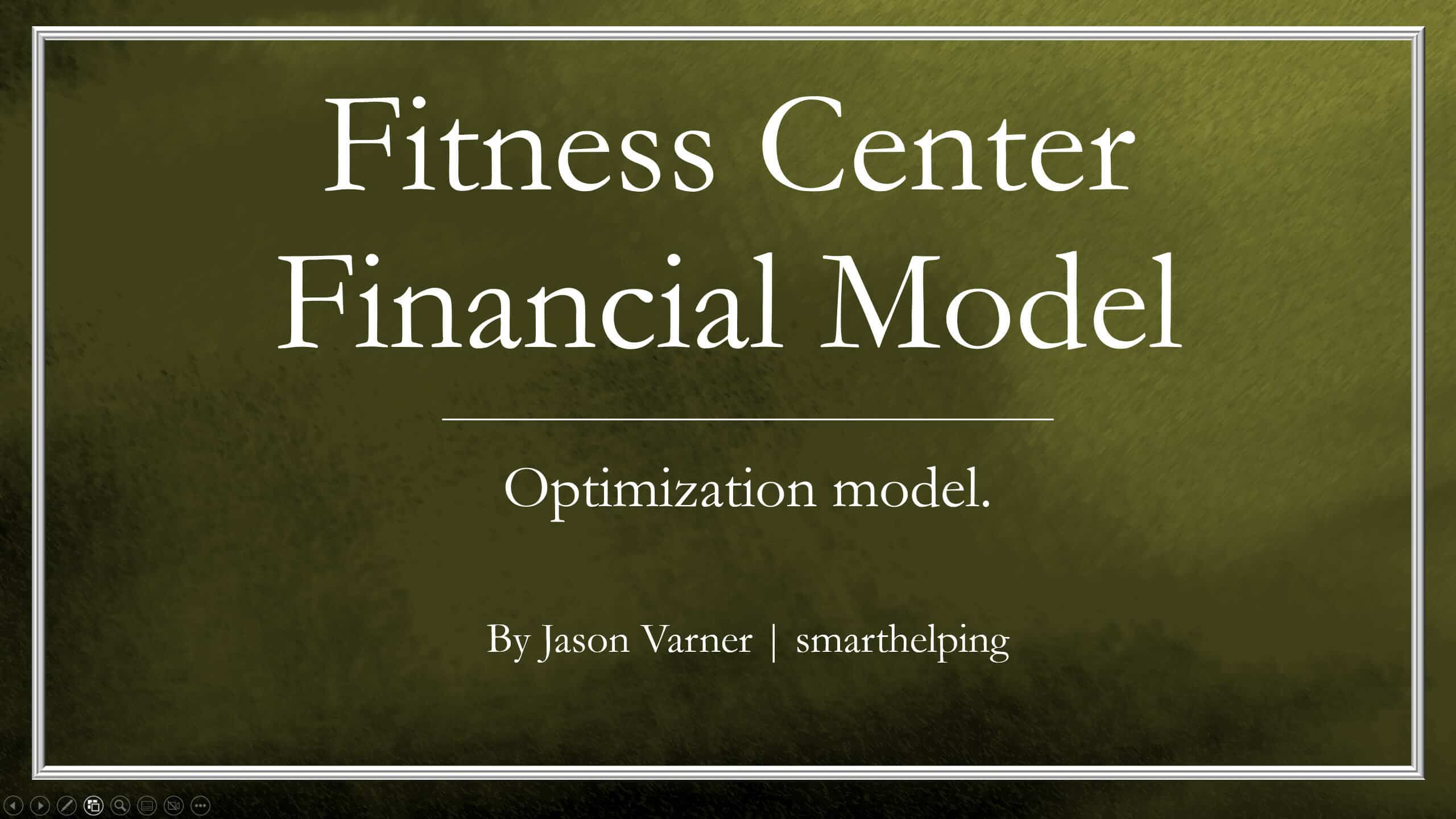Sports Club / Sports Complex 5-Year 3 Statement Financial Projection Model
3 statement 5 year rolling financial projection Excel model for a sports club / sports complex business generating membership revenue, court rental revenue, day visitor fees, product sales (sports shop, cafeteria), service revenue (personal training, childcare) and other ancillary income (events, tournaments)

PURPOSE OF MODEL
Highly versatile and user-friendly Excel model for the preparation a of 5-year rolling 3-statement (Income Statement, Balance Sheet, and Cash flow Statement) financial projection with a monthly timeline for a startup or existing sports club or sports complex business generating membership fee revenue together with revenue from court rentals, day visitors, provision of services (e.g., child care, personal training), product sales (Cafeteria, sports shop, etc.) and other ancillary income.
The model allows the user to model up to 5 different membership offerings, each with 3 timeline options (monthly, quarterly, and yearly) and renewal/churn rates to estimate the number of members over time. The model includes 5 categories for each of the other revenue sources (court rentals, day visitors, services, product sales, and other income), making it a versatile and comprehensive model for any business or person operating or investing in a sports club or complex.
The model follows good practice financial modelling principles and includes instructions, line item explanations, checks, and input validations and incorporates a discounted cash flow valuation calculation using the projected cash flows.
KEY OUTPUTS
The key outputs include:
– Projected full financial statements (Income Statement, Balance Sheet, and Cash flow Statement) presented on a quarterly basis across up to 5 years and summarised on an annual basis.
– Dashboard with:
o Summarised projected Income Statement and Balance Sheet;
o Compounded Annual Growth rate (CAGR) for each summarised income statement and Balance Sheet line item;
o List of key ratios including average revenue growth, average profit margins, average return on assets and equity, and average debt to equity ratio;
o Bar charts summarising income statement and Balance Sheet projections;
o Chart presenting revenue mix and total revenue by revenue stream per month
o Gross profit by revenue stream
– Discounted cash flow valuation using the projected cash flow output.
– Breakeven analysis
KEY INPUTS
Inputs are split into Income Statement and Balance Sheet Inputs. Most inputs include user-friendly line item explanations and input validations to help users understand what the input is for and populate correctly.
Setup Inputs:
– Name of business;
– Currency;
– First projection year and month;
– Naming for revenue, cost, fixed asset, and borrowing categories
– Sales tax applicability for revenue and cost categories;
Actuals Inputs:
– Opening balance sheet (for existing businesses);
– Income Statement actuals (for trend analysis);
Projection Inputs:
– Membership Revenue
o Volume of New Users;
o Monthly, annual, and quarterly membership mix;
o Renewal rates;
o Membership prices;
– Court Rental Revenue
o Number of courts;
o Maximum turnover per court;
o Average utilization;
o Court rental fees;
– Day Visitor revenue, Service Revenue, and Other Income
o Volume and Rate / revenue per unit;
– Product Sales
o Transaction volumes and average spend per transaction;
– Variable Costs including:
o Cost per sale and per member for membership revenue;
o Variable cost percentages for service revenue and other income;
o Cost of sale percentages and safety stock percentage for product sales;
o Average Credit terms received;
– Other cost inputs, including
o Marketing costs;
o Staff costs;
o Other costs;
– Sales and corporate tax inputs, including rate and payment periods;
– Dividend inputs, including the amount or percentage of retained earnings and frequency;
– Fixed Assets, including additional amounts and useful life;
– Borrowings including addition/redemption amounts and interest rate;
– Share Capital additions.
MODEL STRUCTURE
The model comprises of 9 tabs split into input (‘i_’), calculation (‘c_’), output (‘o_’), and system tabs. The tabs to be populated by the user are the input tabs (‘i_Setup’, ‘i_Actuals’, and ‘i_Assumptions’). The calculation tab uses the user-defined inputs to calculate and produce the projection outputs, which are presented in ‘o_Fin Stats’, ‘o_Charts’, and ‘o_DCF’.
System tabs include:
– A ‘Front Sheet’ containing a disclaimer, instructions, and contents;
– A Checks dashboard containing a summary of checks by tab.
KEY FEATURES
Other key features of this model include the following:
– The model follows best practice financial modelling guidelines and includes instructions, line item explanations, checks, and input validations;
– The model is not password protected and can be modified as required following download;
– The model contains a dynamic timeline that allows for a mix of actual and forecast periods across a 5-year period allowing projections to be rolled forward from month to month;
– Timeline is split on a monthly basis and summarised on an annual basis;
– Costs are split into: variable and fixed for better driver-based forecasting;
– The model allows for the following number of underlying categories for each line item (these can be easily expanded if required):
o Membership options – 5 options
o Court rental revenue – 5 categories
o Day Visitor revenue – 5 categories
o Service revenue – 5 categories
o Product revenue – 5 categories
o Other income – 5 categories
o Staff costs – 8 categories;
o Marketing costs – 5 categories;
o Other expenses – 15 categories;
o Fixed Assets – 5 categories;
o Borrowings – 3 facilities;
– Apart from projecting revenue and costs, the model includes the possibility to model inventory, deferred income, payables, fixed assets, borrowings, dividends, corporate tax, and sales tax;
– The model included an integrated discounted cash flow valuation using the projected cash flow outputs;
– Business name, currency, and starting projection period are fully customizable;
– Revenue, cost, fixed asset, and Borrowing category descriptions are fully customizable;
– The model includes instructions, line item explanations, checks, and input validations to help ensure input fields are populated accurately;
– The model includes a checks dashboard that summarises all the checks included in the various tabs making it easier to identify any errors.
MODIFICATIONS
If you require any be-spoke modifications to the tool, we are more than happy to assist with this. Please send us a private message or contact us through the support team at: [email protected]
ABOUT PROJECTIFY
We are financial modelling professionals with experience working in big 4 business modelling teams and strong experience supporting businesses with their financial planning and decision support needs. Our aim is to provide robust and easy-to-use tools that follow good practice financial modelling guidelines and assist individuals and businesses with their financial projection and analysis requirements.
We are keen to ensure our customers are satisfied with the models they purchase and will be more than happy to assist with any questions or support required.
We are also always keen to receive feedback, so please do let us know what you think of our models by sending us a message or submitting a review.
Similar Products
Other customers were also interested in...
Pilates & Yoga Studio Financial Model – 5 Ye...
Financial Model provides an advanced 5-year financial plan for a startup or operating Pilates & ... Read more
Racket Sports Financial Model Bundle
This bundle of financial model templates tailored to racket sports businesses aims to provide a soph... Read more
Personal Training Service Financial Model Excel Te...
Check Our Personal Training Service Financial Model. Includes inputs, outputs and charts to present ... Read more
Personal Training Financial Model Excel Template
Personal Training Financial Plan Based on years of experience at an affordable price. Buy Now Person... Read more
Yoga and Pilates Studio DCF Financial Model
Yoga and Pilates Studio DCF Financial Model is a tool that enables you to evaluate the feasibility o... Read more
Fitness Center 10 Year Financial Model
Key logic designed to forecast cash flow up to 10 years for a fitness center that has recurring mont... Read more
Recreation & Community Center – Dynamic 10 Y...
Financial Model presenting a development and operating scenario of a Recreation & Community Cent... Read more
Start Up Gym / Fitness Financial Model
Start Up Gym Club Financial Model presents the case of an investment in a gym, fitness club and its ... Read more
Multi Sports Complex Financial Model – Dynam...
Financial Model presenting a development and operating scenario of an Indoor Multi-Sports & Fitn... Read more
Tennis Club Financial Model – 5 Year Forecast
This Financial Model presents an advanced 5-year financial plan for a startup Tennis Club and is a f... Read more
You must log in to submit a review.



















